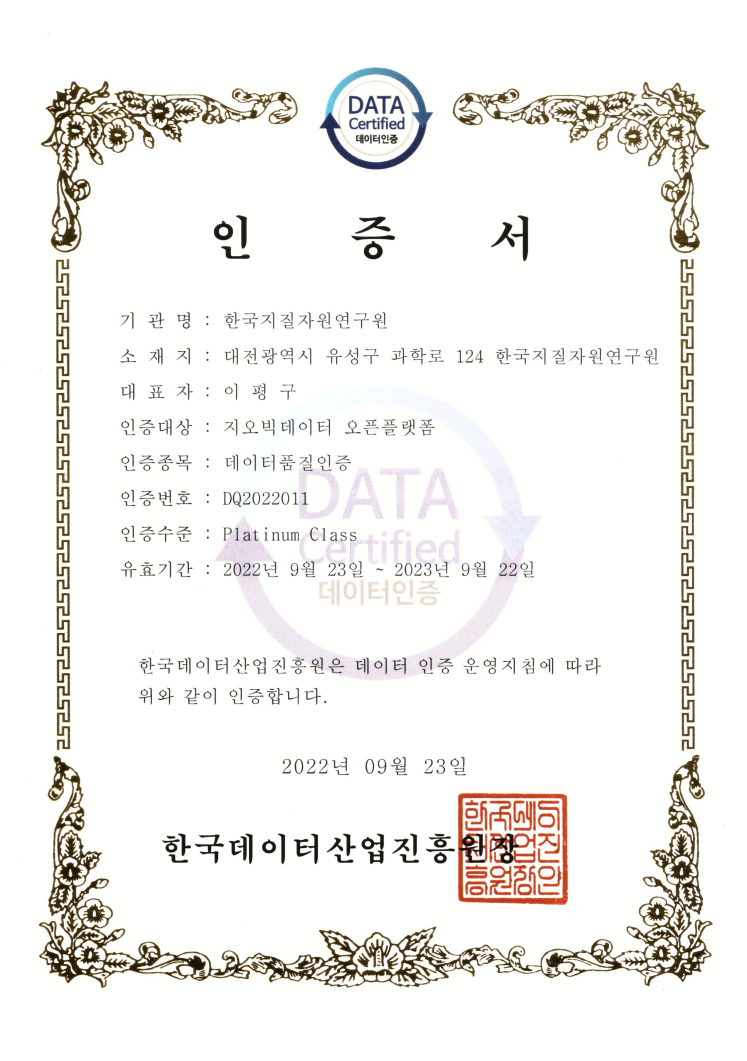Data Quality Certification (DQC-V)

| Data type | KIGAM 보고서 |
|---|---|
| Title | 한반도 해역 조사 및 해저지질도 작성 연구 : 제주 남부 해역 |
| Author | 이치원 |
| Language | KOR |
| Call Number | KR-98-C-37-1998-R |
| Publication Information | 韓國資源硏究所, 1998 |
| Abstract | : This annual report (1998) is a result of marine geological and geophysical surveys for mapping project of the Korean continental shelf geology by the Korea Institute of Geology, Mining and Materials (KIGAM). The 1998 study area is situated off the Cheju Island, the southern part of the far South Sea (eastern East China Sea), and located on latitude 29°30′N to 31°30′N and longitude 125°00′' E to 126°30′E. The surveys produced five kinds of map: 1) submarine topography, 2) surface-sediment distribution, 3) seismic and geologic profiling. 4) gravity anomaly, and 5) magnetic anomaly. A geophysical survey of 2,125 line-km consists of water-depth sounding using multi-beam and single-beam echo-sounder, 3.5kHz subbottom profiling, and airgun seismic-reflection profiling and measurement of magnetic and gravity intensity using gradiometer and gravitymeter. Based on onboard interpretation of geophysical data, 37 sediment cores of several-meter length were raised from proper sites. The survey vessel, R/V Tamhae II, was positioned by the Global Positioning System (GPS). The seafloor progressively deepens southeastward with minor belt-like topographic relieves trending NW-SE. The southeastern deeper seafloor extends seaward southeastly into the Okinawa Trough. Gravity anomaly and magnetic anomaly range from -10 to 30 mgal and from -200 to 0 gamma, respectively. These variations are compatible to the irregularity of the basement which is also shown from deep seismic profiles. On the deep-seismic sections, four stratigraphic units are recognized above the acoustic basement on the basis of bounding discontinuities and reflection configuration. In the acoustic basement, seismic characters of partly-distinct faint stratification mingled with high irregular signals of the basement surface suggest that the basement comprises sedimentary complexes with volcanic and igneous intrusions. Two lower stratigraphic units are suggestive of Miocene non-marine (fluvial?) succession, whereas two upper units are interpreted as post-Pliocene marine succession Four sedimentation units of high-resolution scale are recognized from 3.5kHz subbottom profiles; Unit I (higstand systems tract), Unit II (late transgressive system tract), Unit III (early transgressive system tract) and Unit IV (lowstand systems tract). Unit II can be divided into three subunits IIa (transgressive sand ridge), IIb (transgressive sand sheet) and IIc (transgressive deltaic deposits). Surface to near-surface deposits are divisible into 8 sedimentary facies: homogeneous mud (Mh), bioturbated mud (Mb), massive sand/mud (SMn), graded sand/mud (SMg), bioturbated sand/mud (SMb), bioturbated-laminated sand/mud (SMIb), bioturbated-interlaminated sand/mud (SMib), massive sand (Sm). Most homogeneous mud facies (Mh) originate from post-depositional bioturbation, whereas massive sand facies (Sm) are indicative of current and storm influences during their in situ deposition. The last glacio-eustatic sea-level fluctuation has controlled the formation of a characteristic sequence. The sequence comprises lowstand to early transgressive incised valley fills and late transgressive parasequences. At least three parasequences backstep northwestly in a retrogradational stacking pattern and each parasequence forms a clinoform prograded seaward to the southeast |
| Page | 411 p. |
| Keyword | 한반도, 해역, 해저지질도, 제주, 제주남부, 자료취득, 자료처리, 자료분석, 자료 |
| Source |
http://library.kigam.re.kr/report/1998/한반도해역조사및해저지질도작성연구제주남부해역.pdf |
Comments